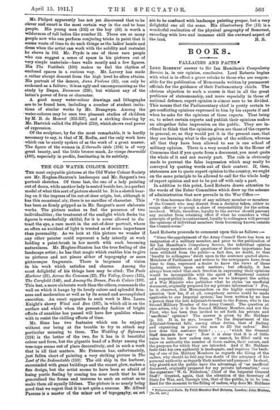THE OLD WATER COLOUR SOCIETY.
THE most enjoyable pictures at the Old Water Colour Society are Mr. Hughes-Stanton's landscapes and Mr. Sargent's two portrait sketches. Of these last, the one of a lady painting out of doors, while another lady is seated beside her, is a perfect model of what this sort of picture should be. It is a sketch bear- ing on it the impress of its out-of-door origin, but, although it has this occasional air, there is no sacrifice of character. This has been as firmly gripped as in Mr. Sargent's most elaborate works. The picture makes us feel the presence of two individualities ; the treatment of the sunlight which flecks the figures is wonderfully skilful, for it is never allowed to dis- tract the eye, a rare merit in the out-of-door portrait, where so often an accident of light is treated as of more importance than personality. As we look at this picture we wonder if any other painter could represent a lady intently at work holding a paint-brush in her mouth with such becoming naturalness. Mr. Hughes-Stanton has the true feeling of the Landscape artist ; he has that magic which enables him to give us pictures and not pieces either of topography or mere picturesque fragments. There is largeness of vision in his work which satisfies and charms. Among the most delightful of his things here may be cited: The Poole Harbour (21), Across the Common (23), The Valley, Greece (125), The Cornfield (148), and Among the Dunes, Pas de Calais (193). This last, a more elaborate work than the others, commands the wall on which it hangs by its lovely colour and splendid firm- ness and moderation as well as by its sound and accomplished execution. An exact opposite to such work is Mrs. Laura Knight's showy Wind and Sun (187), in which all is on the surface and which when the present-day fashion of bright effects of sunshine has passed will have few qualities where- with to resist the chilling effects of time.
Mr. Sims has two fantasies which can be enjoyed without our being at the trouble to try to attach any particular meaning to them. The Wedding of Sylvanus (124) is the better of the two, for it has in it beautiful colour and form, bnt'the gigantic head of a Satyr among the tree-tops seems out of place decoratively, and in such a work that is all that matters. Mr-. Paterson has, unfortunately, just fallen short of painting a very striking picture in The Last of the Indomitable (155. The old ship in the harbour, surrotmded with great buildings and the sunset glow; Makes a fie design, but the artist seems 'to have been so afraid Of losing poetic feeling by coming too near earth that he has generalised the forms and textures to such an extent as to- make them all equally lifeless. The picture' is so nearly being' good that we regret that it is not quite success. Mr. Alfred' Parsons is a master of the minor art of topography, an art uht fo be confused with landscape painting proper, but a very delightful one all the same. His Glastonbury Tor (15) is a wonderful realisation of the physical geography of Somerset, recording with love and immense skill the outward aspeot of




































 Previous page
Previous page